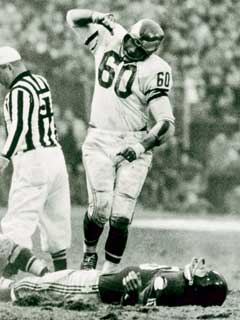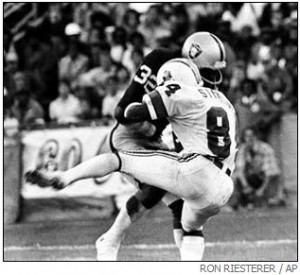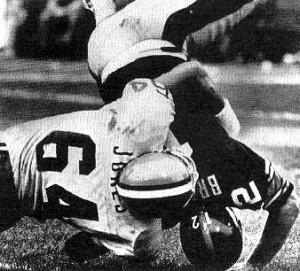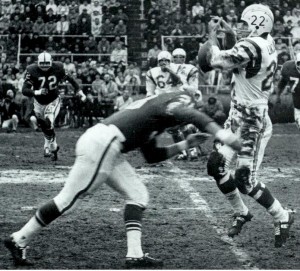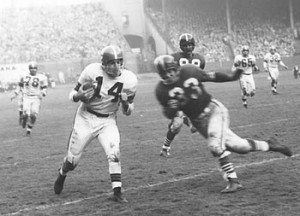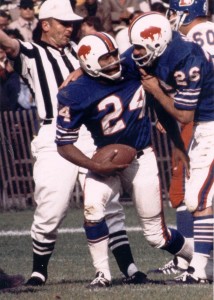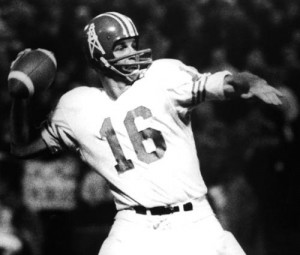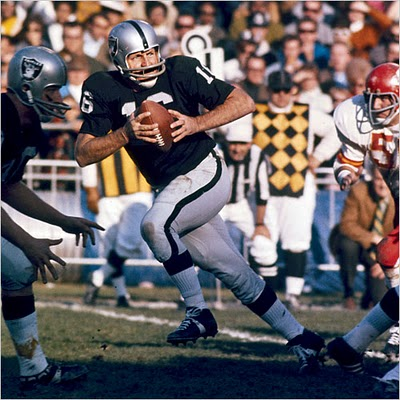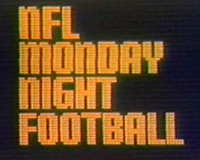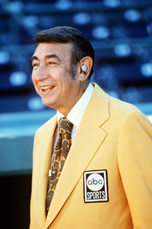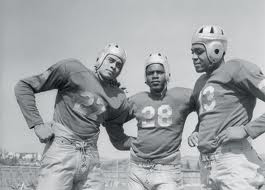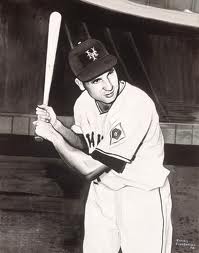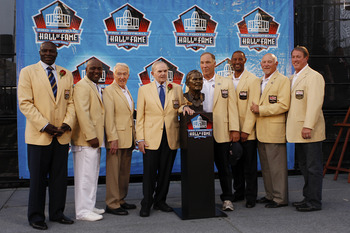Writing the post on Tuesday about last weekend’s rash of violent hits got me to thinking about some of the hardest, most famous hits, and hitters, in NFL history. It sort of proves a point that the problem of vicious hitting in the league isn’t a recent problem. The NFL has actually done a good job of legislating dirty play out of the game, perhaps even going a little too far when it comes to protecting quarterbacks. I still feel the problem is with players not learning the fundamentals – both the fundamentals of hitting, blocking and tackling, and the art of being aware of your surroundings in a game and not putting yourself in vulnerable positions where injuries occur. The following is a rundown of hits and hard-hitting players in the NFL over the years:
During their 1960 championship season, the Philadelphia Eagles played a game against the New York Giants in which their hard-hitting linebacker, Chuck Bednarik, laid out Giants’ back Frank Gifford with a hit so vicious that it not only knocked Gifford unconscious, but sent him to the hospital with a severe concussion. It took Gifford a long time to recover from the symptoms of that concussion, and he didn’t play again in the league until 1962. The ferocity of the hit, along with the fact it involved a player who was a New York “Golden Boy” in Gifford, and a player nicknamed “Concrete Charley” in Bednarik, gave it legendary status. The photo below, of Bednarik standing over the prone Gifford like a predator admiring his prey, is also a stunning visual.
Bednarik admires his prey.
In a 1978 preseason game, Oakland Raiders safety Jack Tatum, whose nickname was “The Assassin”, hit Patriots’ receiver Darryl Stingley so hard on a pass play over the middle that Stingley wound up paralyzed from the chest down. Tatum also was involved in a hit during the Super Bowl, against the Vikings, that knocked the helmet off receiver Sammy White and left White lying whoozy on the ground. Amazingly, the Minnesota receiver actually held onto the ball.
Jack Tatum’s hit on Darryl Stingley.
During the Steelers’ championship era of the 1970s, quarterback Terry Bradshaw was involved in a hit that was so severe that it resulted in rules changes to protect quarterbacks. Cleveland Browns’ defensive lineman Joe “Turkey” Jones sacked Bradshaw by picking him up and “piledriving ” him head first into the turf, leaving the Steelers’ QB unconscious on the field. Bradshaw wound up with a concussion, and Jones was fined $3,000.
Jones piledrives Bradshaw into the turf.
In the 1964 American Football League championship game, Bills’ linebacker Mike Stratton hit Chargers’ back Keith Lincoln on a swing pass with a clean hit that injured Lincoln’s ribs and knocked him out of the game. The play became known in AFL annals as “The Hit Heard ‘Round The World”, as it turned momentum in Buffalo’s favor. The Bills won 20-7 for the first of back-to-back titles. The injury to Lincoln was unfortunate, but notice Stratton’s perfect tackling form below, leading with his shoulder and wrapping up the runner with his arms.
The Hit Heard ‘Round The World.
Hardy Brown was an obscure linebacker for the 49ers in the 1950s who became legendary for his hitting. There isn’t one incident involving Brown that is a lasting image, like Bednarik’s hit on Gifford, but Brown’s technique of winding up his shoulder and hitting opponents, knocking them back sometimes up to 10 yards, became legendary. He knocked out 21 players in the 1951 season, and once knocked out an entire team’s backfield in a single game. Playing in the era before the dawn of face masks, Brown also fractured an opponent’s face, almost took out a running back’s eye, and crushed another player’s vertebrae. He was banned from his own team’s practices by coach Buck Shaw.
Hardy Brown about to unload on Otto Graham.
